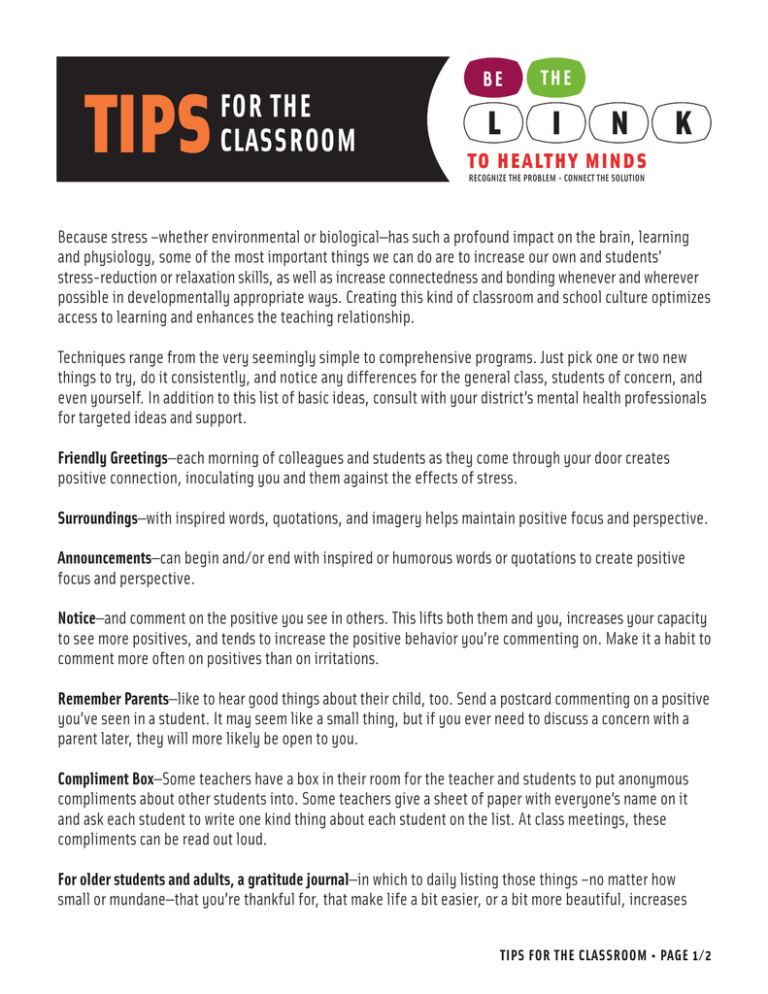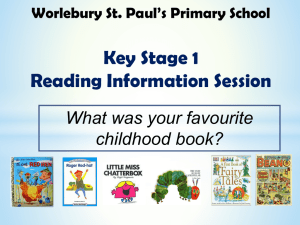TIPS K L I
advertisement

TIPS FOR THE CLASSROOM BE THE L I N K TO H EA LT H Y MI N D S RECOGNIZE THE PROBLEM - CONNECT THE SOLUTION Because stress –whether environmental or biological—has such a profound impact on the brain, learning and physiology, some of the most important things we can do are to increase our own and students’ stress-reduction or relaxation skills, as well as increase connectedness and bonding whenever and wherever possible in developmentally appropriate ways. Creating this kind of classroom and school culture optimizes access to learning and enhances the teaching relationship. Techniques range from the very seemingly simple to comprehensive programs. Just pick one or two new things to try, do it consistently, and notice any differences for the general class, students of concern, and even yourself. In addition to this list of basic ideas, consult with your district’s mental health professionals for targeted ideas and support. Friendly Greetings—each morning of colleagues and students as they come through your door creates positive connection, inoculating you and them against the effects of stress. Surroundings—with inspired words, quotations, and imagery helps maintain positive focus and perspective. Announcements—can begin and/or end with inspired or humorous words or quotations to create positive focus and perspective. Notice—and comment on the positive you see in others. This lifts both them and you, increases your capacity to see more positives, and tends to increase the positive behavior you’re commenting on. Make it a habit to comment more often on positives than on irritations. Remember Parents—like to hear good things about their child, too. Send a postcard commenting on a positive you’ve seen in a student. It may seem like a small thing, but if you ever need to discuss a concern with a parent later, they will more likely be open to you. Compliment Box—Some teachers have a box in their room for the teacher and students to put anonymous compliments about other students into. Some teachers give a sheet of paper with everyone’s name on it and ask each student to write one kind thing about each student on the list. At class meetings, these compliments can be read out loud. For older students and adults, a gratitude journal—in which to daily listing those things –no matter how small or mundane—that you’re thankful for, that make life a bit easier, or a bit more beautiful, increases TIPS FOR THE CLASSROOM • PAGE 1/2 your capacity for appreciation. For ease, list them in your planner. Those who routinely keep a ‘gratitude journal/list’ will also notice that, at those times when you feel a bit stuck, this practice helps to more quickly restore a healthy perspective. Pay Attention to Breathing— which heightens attention, focus and nourishes the brain. Start your class period or day with a request that students set aside their materials and sit up straight in their chairs (so the diaphragm can move). Ask them to look downward, so that they can focus inward, and just relax and pay attention to their breath. Maybe they notice where the air comes in and out of the nose, or how their chest or belly rises and falls. The first couple of times you lead this 1-minute exercise, students may want to say what it was like for them. After that, you will be able to do the exercise and then in a gentle tone, tell them, “Good…. Now I want you to get out your science book…” and smoothly transition into your lesson for the day! Stretching Counteracts Stress—A hallmark of stress is that our muscles tense without our awareness. One of the quickest, most effective ways to help people stay calm, relaxed, and focused, is to have them physically stretch. Start or end your class with some simple stretches. Ask the physical education teacher which ones are easy and calming. Guided Visualization—this excellent technique can help students before a test or big event. Guided visualization helps us to be relaxed and alert, while accessing many areas of the brain and sensory system to bring integration and enhanced performance. There are excellent books with exercises on guided visualization. Announcing transitions a few minutes before they are to take place. Some students really benefit from being oriented to time and expectation. An easy self-care strategy for the classroom that many teachers include is to tell students, “In about 3 minutes we’re going to be going to lunch. Please finish up your ….and do…x…” Remember those naps and milk in Kindergarten? Did you know research shows “power naps” enhance learning? “A midday snooze reverses information overload. Also, be aware that a 20 percent overnight improvement in learning a motor skill is largely traceable to a late stage of sleep, which some early risers might be missing. Notice the easily overlooked—if a student is especially quiet or tired or different than usual, comment on it and ask them if they are ok. Tell them you care and that you want them to have whatever support they need. Consult with your school’s mental health professional. Shift Judgmental Thoughts by Focusing on Similarities. Bring to mind someone with whom you want to increase positive interaction. Reflect on the things that seem to be barriers to you for appreciating this person. Remember times in your own life when you’ve felt or behaved in a similar manner to this person (even if it was to a lesser degree and even if it seemed justified). Notice how, as a human being, you can simply relate to this basic feeling or behavior. Notice what happens as you sit with this and allow yourself to acknowledge this. Do Something You Enjoy Every Day. Even if it’s just 5 minutes, and as simple as a walk, listening to a favorite song, or sipping that first cup of coffee in the morning, allow yourself to be fully present and to fully enjoy that little moment. TIPS FOR THE CLASSROOM • PAGE 2/2



